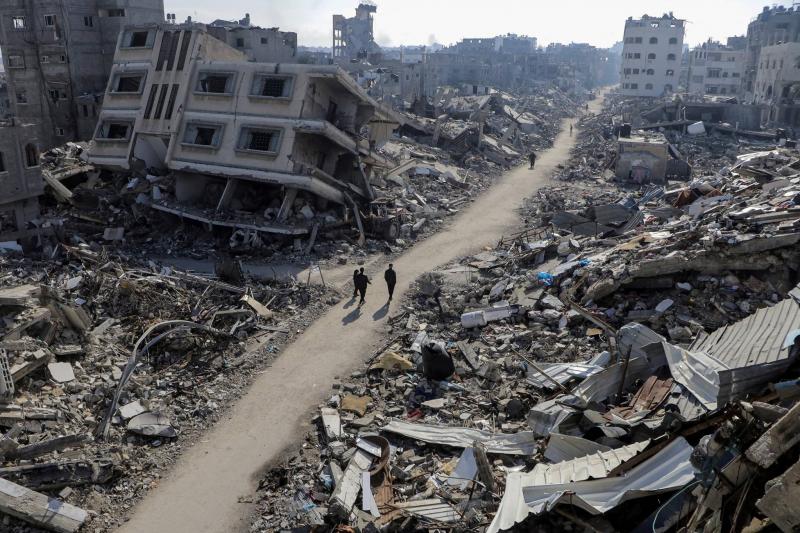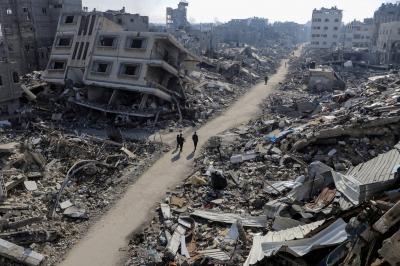As Israeli military operations continue in the Gaza Strip, attention is shifting to the future of the region and what will happen after the war that has displaced hundreds of thousands and killed tens of thousands.
The Wall Street Journal has presented a range of ideas and proposed plans based on sources that include Israeli military officers, retired intelligence personnel, research centers, academics, and politicians. While Israeli political leadership has said very little about how Gaza will look or be governed after the fighting ends, these groups have been working on detailed plans that provide insight into how Israel is contemplating what it calls "the day after."
One of the gaining momentum plans within the government and military involves creating "islands" or "bubbles" where Palestinians not affiliated with Hamas could live in temporary shelters while the Israeli army continues its stated mission to "eliminate Hamas." Other members of the Likud party, led by Prime Minister Benjamin Netanyahu, support a different plan focused on security, which seeks to divide Gaza with two corridors spanning its width, and an enclosed perimeter that "allows the Israeli army to carry out strikes when deemed necessary."
The plans, whether fully adopted or not, reveal harsh realities regarding the consequences of war, including that "Palestinian civilians may be indefinitely confined to smaller areas of the Gaza Strip while fighting continues outside of them." Netanyahu, in rare comments on the issue last week, stated that the government would soon initiate a phased plan to establish a civilian administration run by local Palestinians in northern areas, adding that he "hopes for security assistance from Arab countries."
Current and former Israeli officials indicate that Netanyahu is likely referencing the "bubble plan" discussed among policymakers. According to sources familiar with the matter, the plan aims to work with Palestinians not affiliated with Hamas to create isolated areas in northern Gaza. Palestinians would be distributed in regions that Israel believes Hamas no longer controls, and ultimately a coalition of the United States and Arab countries would manage this process.
**"Ziv Plan"**
Israeli General Amos Ziv, who contributed ideas for removing Hamas from Gaza, stated, "Decisions need to be made today." Ziv, who oversaw Israel's disengagement from Gaza in 2005, suggests that "Palestinians willing to denounce Hamas should be able to register to live in fenced geographical ‘islands’ adjacent to their neighborhoods, guarded by Israeli forces, which would grant them the right to rebuild their homes." The process would be "gradual," with the long-term view of reinstating the Palestinian Authority, centered in the West Bank, back to Gaza as a political solution, considering the entire process could take nearly 5 years.
Under his plan, Hamas can become part of Gaza’s administration "if it releases all hostages held there and disarms to become a purely political movement."
**Other Plans**
According to another plan developed by a nonprofit organization called "Mind Israel," the October 7 attacks and the subsequent war imply that Israelis and Palestinians can no longer engage with each other in good faith. This plan calls for working with the U.S. and Arab governments to create a new Palestinian governing body aimed at what it terms "cessation of terrorism against Israel." The plan states that discussions about establishing a Palestinian state should commence five years post-war, as "after Hamas' attacks on October 7, the movement should not be rewarded with statehood now."
Another proposal published by the Wilson Center suggests that the United States should establish an international police force to manage security in Gaza, eventually handing over the mission to an unspecified Palestinian administration over time. Robert Silverman, a former U.S. diplomat in Iraq who participated in crafting the plan, mentioned that his team had discussed it with Israeli officials for several months, even modifying parts of the proposal to align it with Israeli wartime objectives and political dynamics, but it stalled with Netanyahu’s office.
Another document, drafted by Israeli academics and reviewed by Netanyahu's office, relies on historical precedents for rebuilding war-torn areas in Germany and Japan after World War II, as well as more recently in Iraq and Afghanistan. It examines how to address Hamas' ideology by "learning from the defeat of ideologies such as Nazism and ISIS."
The 28-page document, which the Wall Street Journal had access to, acknowledges that "the process of denazification and identifying new leadership will be long and complex and should start as soon as possible, especially in light of the humanitarian situation in Gaza." All proposed plans assume that "Israel will eventually leave Hamas disarmed, both politically and militarily."




